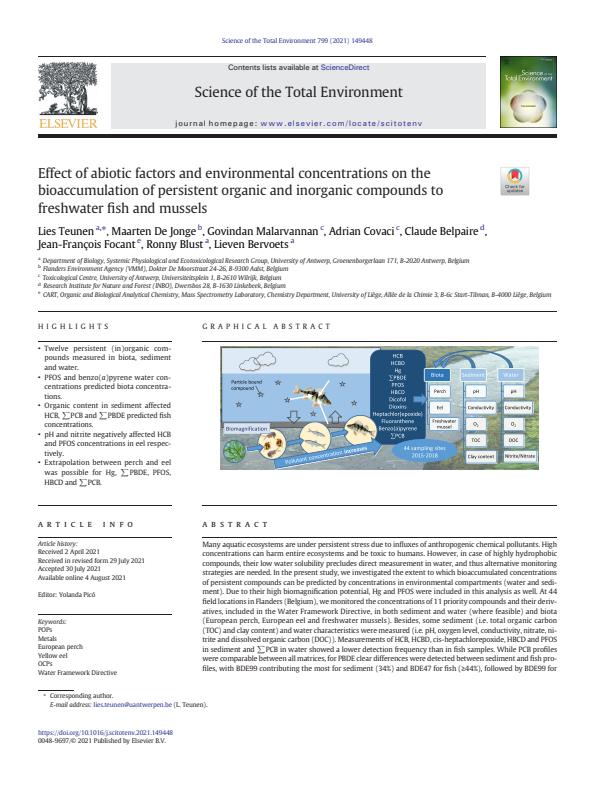Effect of abiotic factors and environmental concentrations on the bioaccumulation of persistent organic and inorganic compounds to freshwater fish and mussels
Details
| Volume | 799 |
|---|---|
| Type | A1: Web of Science-article |
| Category | Research |
| Magazine | Science of the total environment |
| Issns | 0048-9697 |
| Publisher | Elsevier |
| Language | English |
Bibtex
@misc{1e48d9e4-c856-41a0-8d01-60b697cdef27,
title = "Effect of abiotic factors and environmental concentrations on the bioaccumulation of persistent organic and inorganic compounds to freshwater fish and mussels",
abstract = "Many aquatic ecosystems are under persistent stress due to influxes of anthropogenic chemical pollutants. High concentrations can harm entire ecosystems and be toxic to humans. However, in case of highly hydrophobic compounds, their low water solubility precludes direct measurement in water, and thus alternative monitoring strategies are needed. In the present study, we investigated the extent to which bioaccumulated concentrations of persistent compounds can be predicted by concentrations in environmental compartments (water and sediment). Due to their high biomagnification potential, Hg and PFOS were included in this analysis as well. At 44 field locations in Flanders (Belgium), we monitored the concentrations of 11 priority compounds and their derivatives, included in the Water Framework Directive, in both sediment and water (where feasible) and biota (European perch, European eel and freshwater mussels). Besides, some sediment (i.e. total organic carbon (TOC) and clay content) and water characteristics were measured (i.e. pH, oxygen level, conductivity, nitrate, nitrite and dissolved organic carbon (DOC)). Measurements of HCB, HCBD, cis-heptachlorepoxide, HBCD and PFOS in sediment and ∑PCB in water showed a lower detection frequency than in fish samples. While PCB profiles were comparable between all matrices, for PBDE clear differences were detected between sediment and fish profiles, with BDE99 contributing the most for sediment (34%) and BDE47 for fish (≥44%), followed by BDE99 for perch (28%) and BDE100 for eel (25%). Water concentrations for PFOS and benzo(a)pyrene were predictive of respective bioaccumulated concentrations. HCB, ∑PCB and ∑PBDE, concentrations in fish were dependent on sediment concentrations and negatively related to organic compound levels (p <0.05). Furthermore, pH and nitrite were negatively associated with accumulated concentrations in eel for HCB and PFOS, respectively (p <0.05). Strong relationships between bioaccumulation and sediment and/or water concentrations strengthened the basis for surrogate monitoring methods. Finally, the extrapolation potential of Hg, ∑PBDE, PFOS, HBCD and ∑PCB between both fish species offered new opportunities in extrapolating different European monitoring frameworks.",
author = "Lies Teunen and Maarten De Jonge and Govindan Malarvannan and Adrian Covaci and Claude Belpaire and Jean-François Focant and Ronny Blust and Lieven Bervoets",
year = "2021",
month = dec,
day = "01",
doi = "https://doi.org/10.1016/j.scitotenv.2021.149448",
language = "English",
publisher = "Elsevier",
address = "Belgium,
type = "Other"
}
Authors
Lies TeunenMaarten De Jonge
Govindan Malarvannan
Adrian Covaci
Claude Belpaire
Jean-François Focant
Ronny Blust
Lieven Bervoets

